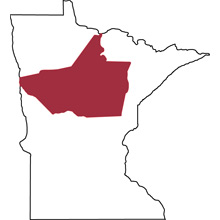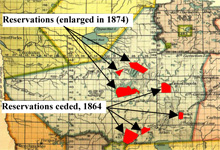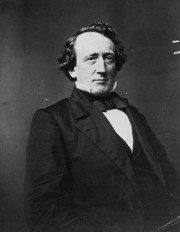1855 Land Cession Treaty with the Ojibwe
Signed February 22, 1855 in Washington, D. C.
With the complete collapse of the fur trade, the 1855 treaty marked a sea change in the economics of the Ojibwe.
First, the source of sustenance for Ojibwe people would become much more dependent upon annuity payments. These annual payments from the US, promised in exchange for the transfer of millions of acres, would be needed to supplement hunting, fishing and other use of a land base exponentially reduced to scattered reservations within the ceded territory. Material survival would depend on the willingness of the U.S. government to honor its commitments. The annuity system, however, was vulnerable to fraud. Annuity recipients had to show up at appointed times and places to receive their funds, and any funds not distributed could be pocketed by the Indian agents in charge of annuities. In 1861, for example, Ojibwe agent Lucius Walker wrote to Dakota agent Clark W. Thompson:
"I hope that the time of payment will be kept a perfect secret. No one excepting those whom we want or need to assist ought to know anything about it. . . You nor I want any one here but them who can render us assistance."—Mark Diedrich in Chief Hole-in-the-Day and the 1862 Chippewa Disturbance, Minnesota Monthly, Spring 1987
Secondly, by allotting reservation land to individual families, the U.S. attempted in the Treaty of 1855 to replace the centuries-old spiritual connection of Ojibwe people to the land with a new system of private property. The U.S. intended Ojibwe people to be farmers on individually-owned plots of land, and promised to plow 675 acres of land for the entire Ojibwe population. (It also provided 80 acres each to mixed-blood individuals, and gave missionaries the option to buy 180 acres each.)
In years to come, various tracts of reservation land established in the Treaty of 1855 would be enlarged, ceded, stolen, restored, co-opted and vacated through treaties, acts of Congress, and the actions of corporations, Indian agents and other “entrepreneurs.” Throughout this complicated history, the Leech Lake and Mille Lacs Bands of Chippewa held on to the land that includes their current reservations.
In the 1990s, the U. S. Supreme Court held that this treaty did not cede rights to land use that the Ojibwe had retained in the 1837 land cession treaty.









